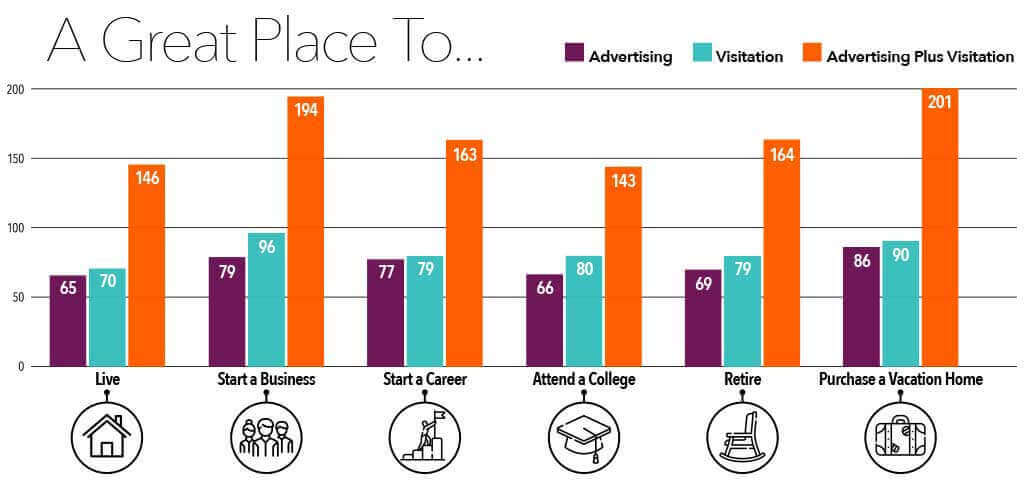Talent Recruitment: Destination Marketing for Economic Development
May 26, 2021
Communities are looking to recover from a difficult financial year. Investing in destination marketing can attract both tourists and new residents—boosting local economies. Most destination marketers understand the collective impact DMOs, CVBs, and CTBs have on local economies. Tourism brings with it spending from travelers and creates jobs. However, destination marketing also boosts economies through talent recruitment and business relocations—turning visitors into residents.
2020 Economic Impact Stats
Tourism has a ripple effect through communities. Visitors shopping at main street businesses boost local economies. Public funding generated by tourism-related revenue ensures a community’s children have safe places to play. The impact of tourism delivers lifelong value to residents.
But in 2020, many communities experienced what happens when tourism dries up. Consumer spending dropped 3.9% last year as travel sentiment reached an all-time low. Last year, the percentage of Americans planning a vacation within the country decreased by 40%. Americans with travel plans in the next six months decreased by 32%. These drops in travel sent shockwaves through communities. Since January 2020, cumulative travel spending has decreased by over $590 billion. Though the economy is on the upswing, more than eight million people who lost their jobs last year are still out of work. This includes three million people in the leisure and hospitality industry.
Getting Back on Track
There are signs of hope. Traveler sentiment metrics are increasing as the percentage of Americans vaccinated against COVID-19 climbs. In April 2021, 87% of travelers noted that they have travel plans in the next six months—matching pre-pandemic levels. As travel increases, destinations have an opportunity to boost their local economy, not just through tourism, but through talent recruitment as well. According to a survey from Move.org, 20% of respondents moved in 2020. Of those respondents, 52% relocated to a new city or state, and 36% said their move was work-related.
The Halo Effect
Tourism can serve as a key catalyst for long-term economic sustainability. A Longwoods International study found that consumers who were exposed to destination marketing and visited a destination were nearly twice as likely to choose to live, start a business, start a career, attend college, retire, and purchase a vacation home in that destination.

This Halo Effect can serve as the foundation for destinations’ economic development and talent recruitment strategy. Investing in destination marketing now will attract talent and lead to the establishment of local businesses. As travelers are drawn into the marketing funnel, destinations should keep travelers engaged with tactics that highlight emerging economic opportunities, quality of life value propositions, and proximity to major markets.
Visitors will experience a destination’s attractions, things to do, and sense of community. This gives people a “I could see myself living here!” feeling. When this feeling is paired with DMO-created content about career and education opportunities in the community—visitations turn into relocations.
Talent Recruitment & Retention
Destination marketing offers the opportunity to highlight the top leisure experiences in communities. However, it also gives destinations the chance to promote their communities’ quality of life benefits.
The Madden team worked with Visit Lubbock and Lubbock Economic Development Alliance (LEDA) to build campaigns that targeted people likely to visit and relocate. We dug into data to develop intent-based personas. These personas were segmented by the reasons they choose to travel and live somewhere. These included young professionals who had lived in the region during their college years, people who enjoy cities with vibrant downtown districts, wine lovers, and people who love live music and events.
We developed immersive stories that highlighted Lubbock not just as a great place to visit, but also a fantastic place to live with great employment opportunities. Stories spotlighted local entrepreneurs, regional innovation hubs, the vibrant downtown, local craft shops, and the many quality of life and business-friendly aspects of the destination. We positioned Lubbock as a hub city—a place that has the experiences and attractions of a big city while also being a place where people know each other with work and play close by.
In addition to building out talent recruitment focused content, we deploy specific marketing tactics that align with economic development campaigns. LinkedIn offers destinations the opportunity to targeting people based on their job title, career industry, or where they went to college. As part of our work with Lubbock, we used InMail to target young professionals who had studied at Texas Tech.
Business Relocation & Investment
As you think about your own organization and community, collaborate with economic development offices in your efforts. Those partnerships are key to creating a lasting impact. Visit Tampa Bay and the Tampa Economic Development Commision (TEDC) did just this as they worked with the Madden team to combine tourism and economic development into a holistic campaign. We collaborated to craft an integrated destination marketing strategy and brand that positioned Tampa as the ideal city to relocate for your career and business.
While the leisure side is all about attractions and things to do, economic development efforts highlighted why Tampa Bay is a great place to live, work, and run a business. We developed the Make It Tampa Bay brand to encourage target audiences to make Tampa Bay their city to live, work, and thrive.
We developed a custom website that welcomed users with a bold, vibrant voice and design that aligned with the core Tampa brand of “Unlock Adventure.” Immersive destination stories included tools like cost of living calculators and job searches to increase engagement and get users thinking about relocating to the destination. Additionally, we developed an influencer campaign that leveraged local career makers and business owners to share their professional success in an authentic and inspirational way.
Building an Economy
Examples like our work with Visit Lubbock & LEDA and Visit Tampa Bay & TEDC show how destination marketing and economic development can perfectly align. At its core, destination marketing sparks a person’s imagination and emotionally connects them to a place. Once that connection has been made, destinations can engage their target audiences with messaging that highlights quality of life benefits and career opportunities. As the Halo Effect shows, combining these marketing touch points on top of visitations will make sure that when people visit your community, they never leave.
As communities look to recover from a difficult financial year, investing in destination marketing to attract both tourists and new residents will boost local economies. Most destination marketers understand the collective impact DMOs, CVBs, and CTBs have on local economies. Tourism brings with it spending from travelers and creates jobs. However, destination marketing also boosts economies through talent recruitment and business relocations—turning visitors into residents.



